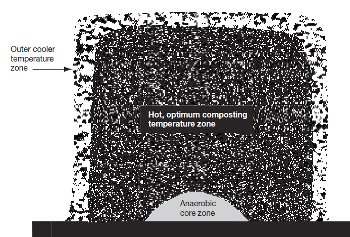Making a Composted Substrate
Many agricultural by-products are used to make mushroom substrate. Straw-bedded horse manure and hay or wheat straw are the common bulk ingredients. «Synthetic» composts are those in which the prime ingredient is not straw-bedded horse manure. If bulk ingredients are high in nitrogen, other high-carbohydrate bulk ingredients — such as corncobs, cottonseed hulls, or cocoa bean hulls — are added to the mix. All compost formulas require the addition of nitrogen supplements and gypsum.
Additional nitrogen-rich supplements are added to composts to increase the nitrogen content to 1.5–1.7 percent for horse manure or 1.7–1.9 percent for synthetic; both are computed on a dry weight basis. Poultry manure is probably the most common and economical source of nitrogen. A variety of meals or seeds, such as cottonseed meal, soybean meal, or brewer’s grain may also be used. Inorganic or nonprotein nitrogen sources such as ammonia nitrate and urea are also used, but only in small amounts when high-carbohydrate bulk ingredients are used. Gypsum is added to minimize «greasiness» and to buffer the pH of the compost. Gypsum increases the flocculation of colloids in the compost, which prevents the straws from sticking together and inhibiting air penetration. Air, which supplies oxygen to the microbes and chemical reactions, is essential to the composting process. Gypsum may be added early in the composting process, at 70–100 lbs per ton of dry ingredients.
A concrete slab, referred to as a wharf, is required for composting (Figure 1). In addition, a compost turner to aerate and water the ingredients and a tractor-loader to move the ingredients to the turner are needed. Water used during a substrate preparation operation can be recycled back into the process. It is, in a sense, a closed system. Water runoff into the environment is nonexistent on a properly anaged substrate preparation wharf. Water collected in concrete pits or a sealed lagoon is aerated and recycled to soak bulk ingredients before the composting process begins.

Figure 1. Traditional compost wharf, showing pre-wet pile on the right and the ricks or windrows on the left.
Conventional Phase I composting begins by mixing and wetting the ingredients as they are stacked. Most farms have a preconditioning phase in which bulk ingredients and some upplements are watered and stacked in a large pile for several days to soften, making them more receptive to water. This preconditioning time may range from 3 to 15 days. The iles are turned daily or every other day. After this pre-wet stage, the compost is formed into a rectangular pile with tight sides and a loose center. A compost turner is typically used to orm this pile. Water is sprayed onto the horse manure or synthetic compost as these materials move through the turner. Nitrogen supplements and gypsum can be spread over the top of he bulk ingredients and are thoroughly mixed by the turner.
Figure 2 is a close-up of a machine «eating» its way through a compost pile. Once the pile is wetted and formed, aerobic fermentation (composting) commences as microbial growth and reproduction naturally ccur in the bulk ingredients. Heat, ammonia, and carbon dioxide (CO2) re released as by-products during this process. Compost activators, other han those mentioned, are not needed.

Figure 2. Self-propelled compost turner moving through a compost rick or pile.
As temperatures increase above 155ºF (70ºC), microorganisms cease growing and a chemical reaction begins. Concentrating and preserving complex carbohydrates is one goal of hase I. The quantity and the quality of nitrogen in the system are changed to a type of nitrogen that Phase II microorganisms and, eventually, the mushroom will use as food.
Adequate moisture, oxygen, nitrogen, and carbohydrates must be present throughout the process; otherwise, the process will stop. This is why water and supplements are added periodically nd the compost pile is aerated as it moves through the turner. Oxygenation is achieved in conventional outdoor ricks by natural convection. The high pile temperatures draw mbient air through the sides of the stack, and as the air is heated, it rises upward through the stack—a process commonly referred to as the chimney effect (Figure 3). The sides of the pile hould be firm and dense, yet the center must remain loose throughout Phase I composting. The exclusion of air results in an airless (anaerobic)
environment. As the straw or hay oftens during composting, the materials become less rigid and more compact while substrate density increases. Thus, less air reaches the bottom and center of the pile. A lack of oxygen may occur after the large quantities of water are added to the dry bulk ingredients and before sufficient heat is generated to start the draw of air into the pile. Under anaerobic conditions, organic acids and other deleterious chemical compounds are formed. Therefore, preparing substrate under aerobic
conditions, where less offensive odors re produced, is better for mushroom growers.

Figure 3. Cross section of a compost pile showing the different
temperature zones and air movement (blue arrows) caused by the chimney effect.
5840 view.